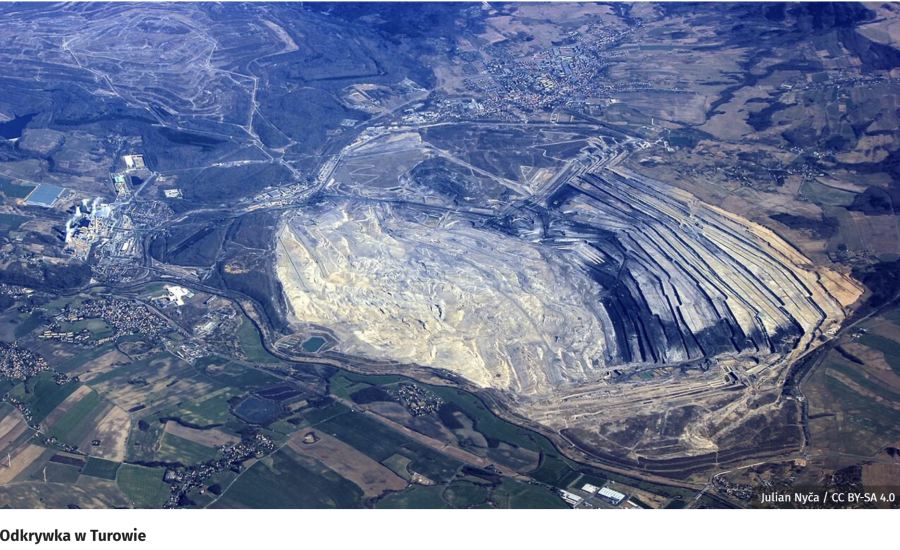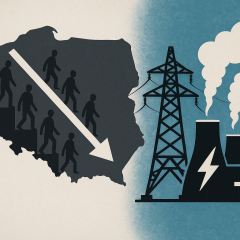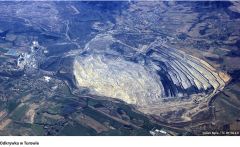PGE, Poland’s largest power utility, faced scrutiny from shareholders during its Annual General Shareholder Meeting. Responses reveal the company’s limited recognition of climate risks and a lack of a clear emissions reduction strategy, despite its reliance on the future growth of renewable energy.
By Paweł Pomian
The PGE Capital Group recently released its financial results for Q1 2025. Recurring EBITDA for the quarter exceeded PLN 4.3 billion (EUR 1.02 billion). As of the end of 2024, the company employed nearly 42,000 individuals. The conventional energy segment reported an 8% decline in employment compared to the end of 2023.
Phase-out of coal in district heating and the largest land reclamation project in Poland
PGE faces a significant challenge: phasing out coal-fired district heating by 2030. Additionally, the company plans to decommission coal power plants, necessitating extensive reclamation of degraded land at its lignite open-pit mines. These changes come alongside major investments in new generation capacity.
“PGE is visibly increasing investments in gas-fired power plants while simultaneously scaling back its projected renewable energy output growth by 2030. This represents a high-risk bet on declining climate ambition - both among financial institutions and energy sector competitors in Poland and across Europe,” says Kuba Gogolewski, Project Coordinator at the Mission Possible Foundation.
Four and a half billion cubic meters of water — amid national shortages
“Even more alarming,” adds Gogolewski, “is that a company preparing to launch the largest land reclamation effort in Poland’s history - requiring over 4,5 billion cubic meters of water, has not engaged with the public, NGOs, institutions, or independent experts, including international ones.”
As Poland grapples with recurring droughts and limited water resources, such opacity only intensifies concerns. Gogolewski emphasizes that a project of this magnitude cannot succeed without transparent, inclusive consultation. - Instead, PGE cites corporate confidentiality and intellectual property rights to withhold access to an updated hydrogeological model of the Turów mine.
“Publishing that model would allow public input, helping maximize societal benefit rather than profits for the company alone. Against this backdrop, it is deeply troubling that the PGE Group Strategy through 2035 contains no clearly defined water management goals,” he adds.
Gogolewski is also concerned by the lack of a methane reduction plan for PGE’s lignite mines, which emitted 41.63 metric tons (Mg) of methane in 2024.
During PGE’s General Annual Shareholders Meeting, the board faced pointed questions but deferred all responses, delivering them in writing two weeks later. PGE’s December 2023 Decarbonization Pathway set a goal of net-zero emissions in district heating by 2040, targeting 80% renewable and electric sources and 20% from eco-fuels and carbon capture. It also aimed to eliminate coal from heating by 2030 - goals that have since been downgraded.
Previously, the PGE Strategy through 2030 envisioned phasing out gas-fired electricity generation by 2042. When asked whether that target still stands, PGE replied:
“That target has been revised. The new Strategy aims to reach 10 GW of flexible gas-fired capacity by 2035. For all gas assets, we are evaluating transitions to decarbonized fuels such as hydrogen or renewable non-biogenic fuels (RFNBO).”
No target for methane emissions reduction
Another question addressed methane emissions—a critical issue in the International Energy Agency’s net-zero roadmap, which calls for full deployment of methane abatement technologies by 2030. So, what were PGE’s 2024 methane emissions by segment?
“PGE GiEK S.A. accounts for the bulk of the Group’s methane emissions, which stem from mining operations at the Bełchatów and Turów mines and are calculated as CO₂ equivalents in our carbon footprint. Lignite mining, due to its nature, emits significantly less methane than underground coal mining. In 2024, methane emissions amounted to 41.63 Mg CH₄. For the District Heating segment, the figure was 31.02 Mg CH₄. The Group’s Strategy does not specify a methane reduction target. Methane emissions from lignite mining are classified as fugitive—they occur diffusely across the entire mining process and are therefore not directly controllable. These emissions will eventually be eliminated through mine closures and post-mining land reclamation,” the Group stated.
NGOs: “PGE isn’t taking climate transition seriously”
“In reality, PGE seems to be betting that financial institutions will also start treating climate risk as a lower priority,” says Gogolewski.
This view is reinforced by PGE’s response to questions about climate-related threats:
“Extreme weather events (climate risks) are not currently considered by insurance or reinsurance markets as significant threats to our assets, and therefore do not materially affect insurance premiums.”
NGOs flagged another major inconsistency: many European financial institutions plan to halt financing companies that derive more than 5% of their revenue from coal after 2030. Meanwhile, PGE’s own 2024 Management Report (p. 197) indicates coal revenue of nearly PLN 29 billion (approx. EUR 6.9 billion) - roughly 45% of total group revenue.
No coal asset spin-off, yet still targeting climate neutrality
In a December 2024 investor presentation, PGE stated that it intended to achieve climate neutrality by 2050, assuming its coal assets would be spun off and transferred to the National Energy Security Agency (NESA). But what happens if the assets remain within PGE?
“The Strategy does not rely on spinning off coal assets. The goal of achieving climate neutrality remains, regardless of whether these assets stay within PGE Group’s ownership structure,” the company clarified.
Aspirations for renewables. Before its most recent update, PGE’s strategy set a long-term goal of delivering “100% renewable energy to PGE customers and fully aligning retail sales with renewable production by 2050.”
In response, PGE explained:
“We’ve chosen better to reflect the increasing energy independence of our customers - enabled by prosumer installations and energy storage systems. We remain committed to growing the share of renewables in PGE’s electricity sales. With continued offshore wind development beyond 2035, the Group is on a strong path toward achieving its 2050 renewable energy goals.”
Link to the original article: https://www.onet.pl/informacje/odpowiedzialny-inwestor/pge-w-ogniu-pytan-na-walnym-zebraniu/5d9xwnj,0666d3f1








